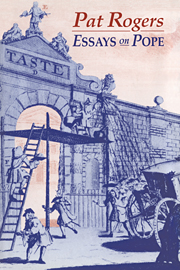Book contents
- Frontmatter
- Contents
- Preface
- Acknowledgements
- List of abbreviations
- 1 Pope and the syntax of satire
- 2 The politics of style
- 3 Form and pattern in the Pastorals
- 4 Windsor-Forest, Britannia and river poetry
- 5 Faery lore and The Rape of the Lock
- 6 Timon's Villa and Chatsworth
- 7 A drama of mixed feelings: the Epistle to Arbuthnot
- 8 The name and nature of Dulness: proper nouns in The Dunciad
- 9 Pope and the social scene
- 10 Blacks and poetry and Pope
- 11 The case of Pope v. Curll
- 12 Pope and his subscribers
- 13 The Burlington circle in the provinces: Pope's Yorkshire friends
- 14 Pope and the antiquarians
- Index
7 - A drama of mixed feelings: the Epistle to Arbuthnot
Published online by Cambridge University Press: 18 December 2009
- Frontmatter
- Contents
- Preface
- Acknowledgements
- List of abbreviations
- 1 Pope and the syntax of satire
- 2 The politics of style
- 3 Form and pattern in the Pastorals
- 4 Windsor-Forest, Britannia and river poetry
- 5 Faery lore and The Rape of the Lock
- 6 Timon's Villa and Chatsworth
- 7 A drama of mixed feelings: the Epistle to Arbuthnot
- 8 The name and nature of Dulness: proper nouns in The Dunciad
- 9 Pope and the social scene
- 10 Blacks and poetry and Pope
- 11 The case of Pope v. Curll
- 12 Pope and his subscribers
- 13 The Burlington circle in the provinces: Pope's Yorkshire friends
- 14 Pope and the antiquarians
- Index
Summary
One of the words critics use most frequently in discussing the Epistle to Arbuthnot is ‘anxiety’. It is certain that this complex poem, so elaborately pieced together out of shreds and patches of verse, caused Pope much trouble in the writing, and possibly in the recollection of painful experiences it called up. At the very outset, jagged cadences suggest indecision as well as weariness:
Shut, shut the door, good John! fatigu'd I said,
Tye up the knocker, say I'm sick, I'm dead …
(1–2)What follows is partly a comedy of indecision, where alternating energies are permitted to drive through the verse, and competing attitudes are allowed to surface at different points. In a sense, Pope has made a virtue out of the disorder of his feelings, and also of the haphazard manner in which the poem was put together.
The Epistle to Arbuthnot survives as one of the few eighteenth-century texts regularly studied in schools and colleges. It would be cynical to ascribe this power of endurance to academic inertia; but my experience suggests that the poem continues to be taught along rather predictable lines. It does not seem to have benefited directly from the great upsurge of scholarly interest in Pope over the last few decades. Unlike many critical revaluations, the new estimate of Pope has been much more than a palace revolution within academic court circles. Many readers who would not claim to be Pope ‘specialists’ have learnt to appreciate the daring mythopoeic invention of The Rape of the Lock, or the surrealist fantasy in The Dunciad. Yet the poem which young people most frequently encounter is still, I would guess, Arbuthnot.
- Type
- Chapter
- Information
- Essays on Pope , pp. 93 - 97Publisher: Cambridge University PressPrint publication year: 1993
- 1
- Cited by

